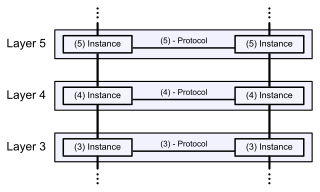Related Research Articles
The Internet protocol suite, commonly known as TCP/IP, is the set of communications protocols used in the Internet and similar computer networks. The current foundational protocols in the suite are the Transmission Control Protocol (TCP) and the Internet Protocol (IP), as well as the User Datagram Protocol (UDP).
Multiprotocol Label Switching (MPLS) is a routing technique in telecommunications networks that directs data from one node to the next based on labels rather than network addresses. Whereas network addresses identify endpoints the labels identify established paths between endpoints. MPLS can encapsulate packets of various network protocols, hence the multiprotocol component of the name. MPLS supports a range of access technologies, including T1/E1, ATM, Frame Relay, and DSL.

The Open Systems Interconnection model is a conceptual model that describes the universal standard of communication functions of a telecommunication system or computing system, without any regard to the system's underlying internal technology and specific protocol suites. Therefore, the objective is the interoperability of all diverse communication systems containing standard communication protocols, through the encapsulation and de-encapsulation of data, for all networked communication.

Telnet is an application protocol used on the Internet or local area network to provide a bidirectional interactive text-oriented communication facility using a virtual terminal connection. User data is interspersed in-band with Telnet control information in an 8-bit byte oriented data connection over the Transmission Control Protocol (TCP).
In computing, Internet Protocol Security (IPsec) is a secure network protocol suite that authenticates and encrypts the packets of data to provide secure encrypted communication between two computers over an Internet Protocol network. It is used in virtual private networks (VPNs).
Network File System (NFS) is a distributed file system protocol originally developed by Sun Microsystems (Sun) in 1984, allowing a user on a client computer to access files over a computer network much like local storage is accessed. NFS, like many other protocols, builds on the Open Network Computing Remote Procedure Call system. NFS is an open IETF standard defined in a Request for Comments (RFC), allowing anyone to implement the protocol.
DECnet is a suite of network protocols created by Digital Equipment Corporation. Originally released in 1975 in order to connect two PDP-11 minicomputers, it evolved into one of the first peer-to-peer network architectures, thus transforming DEC into a networking powerhouse in the 1980s. Initially built with three layers, it later (1982) evolved into a seven-layer OSI-compliant networking protocol.
Systems Network Architecture (SNA) is IBM's proprietary networking architecture, created in 1974. It is a complete protocol stack for interconnecting computers and their resources. SNA describes formats and protocols and is, in itself, not a piece of software. The implementation of SNA takes the form of various communications packages, most notably Virtual Telecommunications Access Method (VTAM), the mainframe software package for SNA communications.
A virtual private network (VPN) extends a private network across a public network and enables users to send and receive data across shared or public networks as if their computing devices were directly connected to the private network. The benefits of a VPN include increases in functionality, security, and management of the private network. It provides access to resources that are inaccessible on the public network and is typically used for remote workers. Encryption is common, although not an inherent part of a VPN connection.

Extensible Messaging and Presence Protocol is an open communication protocol designed for instant messaging (IM), presence information, and contact list maintenance. Based on XML, it enables the near-real-time exchange of structured data between two or more network entities. Designed to be extensible, the protocol offers a multitude of applications beyond traditional IM in the broader realm of message-oriented middleware, including signalling for VoIP, video, file transfer, gaming and other uses.
In computer networking, Layer 2 Tunneling Protocol (L2TP) is a tunneling protocol used to support virtual private networks (VPNs) or as part of the delivery of services by ISPs. It uses encryption ('hiding') only for its own control messages, and does not provide any encryption or confidentiality of content by itself. Rather, it provides a tunnel for Layer 2, and the tunnel itself may be passed over a Layer 3 encryption protocol such as IPsec.
In computer networking and telecommunications, a pseudowire is an emulation of a point-to-point connection over a packet-switched network (PSN).
The Virtual Router Redundancy Protocol (VRRP) is a computer networking protocol that provides for automatic assignment of available Internet Protocol (IP) routers to participating hosts. This increases the availability and reliability of routing paths via automatic default gateway selections on an IP subnetwork.
Extensible Authentication Protocol (EAP) is an authentication framework frequently used in network and internet connections. It is defined in RFC 3748, which made RFC 2284 obsolete, and is updated by RFC 5247. EAP is an authentication framework for providing the transport and usage of material and parameters generated by EAP methods. There are many methods defined by RFCs, and a number of vendor-specific methods and new proposals exist. EAP is not a wire protocol; instead it only defines the information from the interface and the formats. Each protocol that uses EAP defines a way to encapsulate by the user EAP messages within that protocol's messages.
Remote job entry is the procedure for sending requests for non-interactive data processing tasks (jobs) to mainframe computers from remote workstations, and by extension the process of receiving the output from such jobs at a remote workstation.
IP multicast is a method of sending Internet Protocol (IP) datagrams to a group of interested receivers in a single transmission. It is the IP-specific form of multicast and is used for streaming media and other network applications. It uses specially reserved multicast address blocks in IPv4 and IPv6.
In computing, Advanced Program to Program Communication or APPC is a protocol which computer programs can use to communicate over a network. APPC is at the application layer in the OSI model, it enables communications between programs on different computers, from portables and workstations to midrange and host computers. APPC is defined as VTAM LU 6.2
Advanced Peer-to-Peer Networking (APPN) is an extension to the Systems Network Architecture (SNA) "that allows large and small computers to communicate as peers across local and wide-area networks."
Internet Protocol Flow Information Export (IPFIX) is an IETF protocol, as well as the name of the IETF working group defining the protocol. It was created based on the need for a common, universal standard of export for Internet Protocol flow information from routers, probes and other devices that are used by mediation systems, accounting/billing systems and network management systems to facilitate services such as measurement, accounting and billing. The IPFIX standard defines how IP flow information is to be formatted and transferred from an exporter to a collector. Previously many data network operators were relying on Cisco Systems' proprietary NetFlow technology for traffic flow information export.
References
- ↑ "Data-Link Switching (DLSw)". Cisco . Retrieved 2011-06-16.
- ↑ IBM Corporation. "Enterprise Extender" . Retrieved September 3, 2012.
- ↑ "Understanding Enterprise Extender, Part 1 - Concepts and Considerations". IBM . Retrieved 2008-09-15.